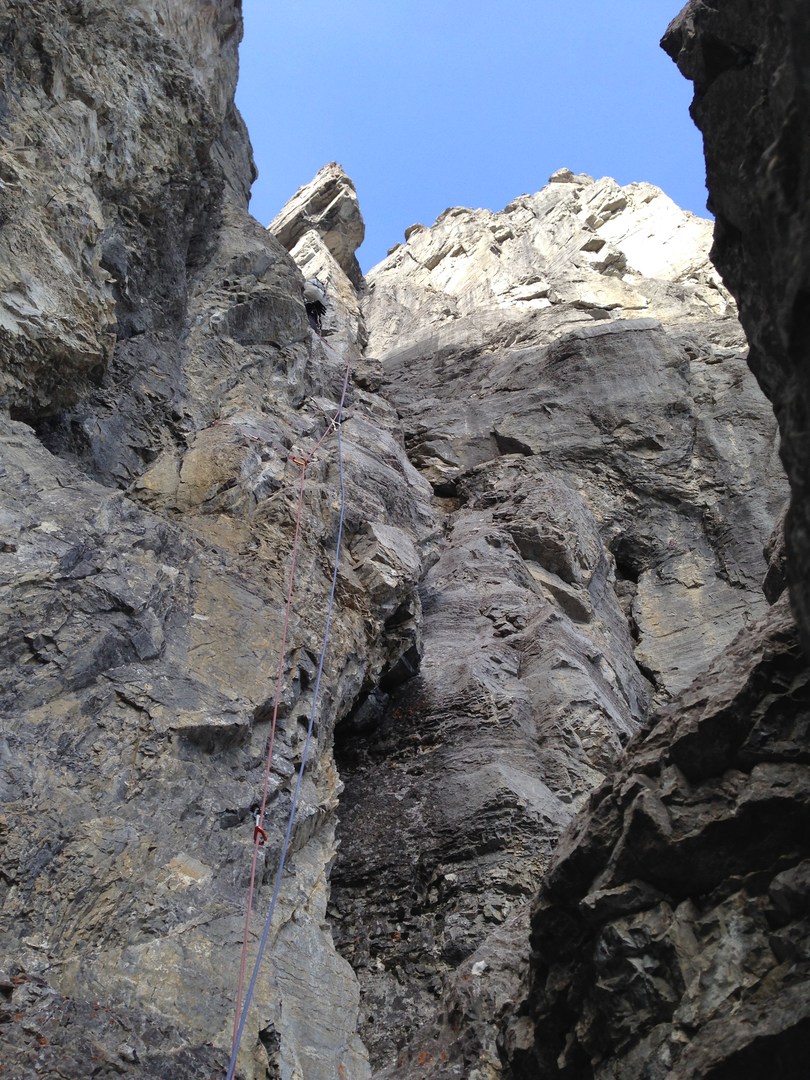You are here
Yamnuska has long been the trad climbing and multi-pitch highlight of Alberta. The massive, imposing face looking out over the Trans-Canada is the first prominent peak as drivers come from the prairies into the Rocky Mountain foothills. The steep imposing face is hard not to marvel at. The first route, and one of the most aesthetically pleasing, is Grillmair's Chimney. It's a classic route in the area first climbed in the 1950s in tennis shoes with a hemp rope and a couple pitons.
Today, the route is one of a few popular options in the Rockies that doesn't have bolted anchors. Belay stations often have a few sketchy pitons. On the route, you will find plenty of old gear.
Yamuska Limestone has a lot of peculiarities. If you haven't trad climbed on Rockies limestone before, it is a very unusual experience. Placements are sparse, and many cracks are caked in calcite, making them unreliable. It's a very humbling experience compared to granite or quartzite. Be prepared to be challenged. Limestone is a sedimentary rock and very unstable, with rockfall audible as soon as the sun hits the face. Even small ledges are littered with gravel and scree. Many pitches of climbing involve scrambling on non-technical, dirty, and scree surfaces to make moves on blank slabs. Approach shoes can be very handy for these frequent technical to non-technical moves.
Approach
Follow the hiking trail to the four-way junction and take the Climber’s Trail sign. This winds through steadily thinning brush. Follow the trail until you get to the traverse trail running directly beneath the mountain. Due to the frequent rock fall, it’s recommended to pop your helmet on before you get beneath the wall.
The route is somewhat obvious, even from below. The large corner and prow casts a shade along much of the route here. Grillmair’s Right, the main route, essentially follows a slash-like corner system that is dead vertical to the climber's immediate left, trending right and up into the gloom six pitches above. If you follow this obvious corner down, it gets to a long ledge system sitting above the traverse trail. To gain this ledge, look for a short, steep, 5.5 move at the apex of a scree field. There is a small sapling immediately adjacent to the step. Above this the ledge are several small trees.
Grillmair's first pitch is the easiest on this wall; look for a blocky pillar. A small sapling sits beside a crack. You can either follow this crack or go a bit more to the right, up a blocky section of 5.6 with a piton a third of the way up. Head for a bulging pillar 50 meters from the ledge with a small tree on it. The left-hand side of this pillar is the easier side.
For information on the route, see Yamnuska Rock, a guidebook written by Andy Genereux. Generally speaking, the climb is fun and follows the right-trending slash. The highlight is the uppermost pitches that lead into the chimney itself. It's about 1.5 meters wide and narrows as you move up and eventually right inside of it. It often takes a few moments to adjust to the gloom, then you can make out the sliver of light leading to the top out. The route squeezes through a tiny gap in the rocks on the other side of the mountain right beside the hiking trail.
Follow the trail east toward the end of the crag. Once you pass through the pillars at the end of Yamnuska Rock, you can head east along the hiker's trail or take the climber's trail south. The southern trail is steep, but shorter, while the hiker's trail is more comfortable, but covers more distance.
Gear
- A helmet, a harness, and a belay device
- Trad Rack:
- Blue to Grey (0.3 to 4 in) in DMM, Wild Country, or Black Diamond cams
- Purple to Blue (0.5 to 3 in) is also adequate (0.75 to 2 in are the most common placements along with midsize nuts)
- Two 120-centimeter slings
- One 240-centimeter sling
- Six 60-centimeter slings or alpine draws
- Six draws
- Half ropes are recommended as the pitches are around 60 meters in length
- Approach shoes or rock shoes
- A hammer. The many pitons on this route lead some folks to bring a hammer to double check. Not necessary, but handy for the paranoid.
Logistics + Planning
Current Weather: Powered by Dark Sky






























Comments
Sign In and share them.